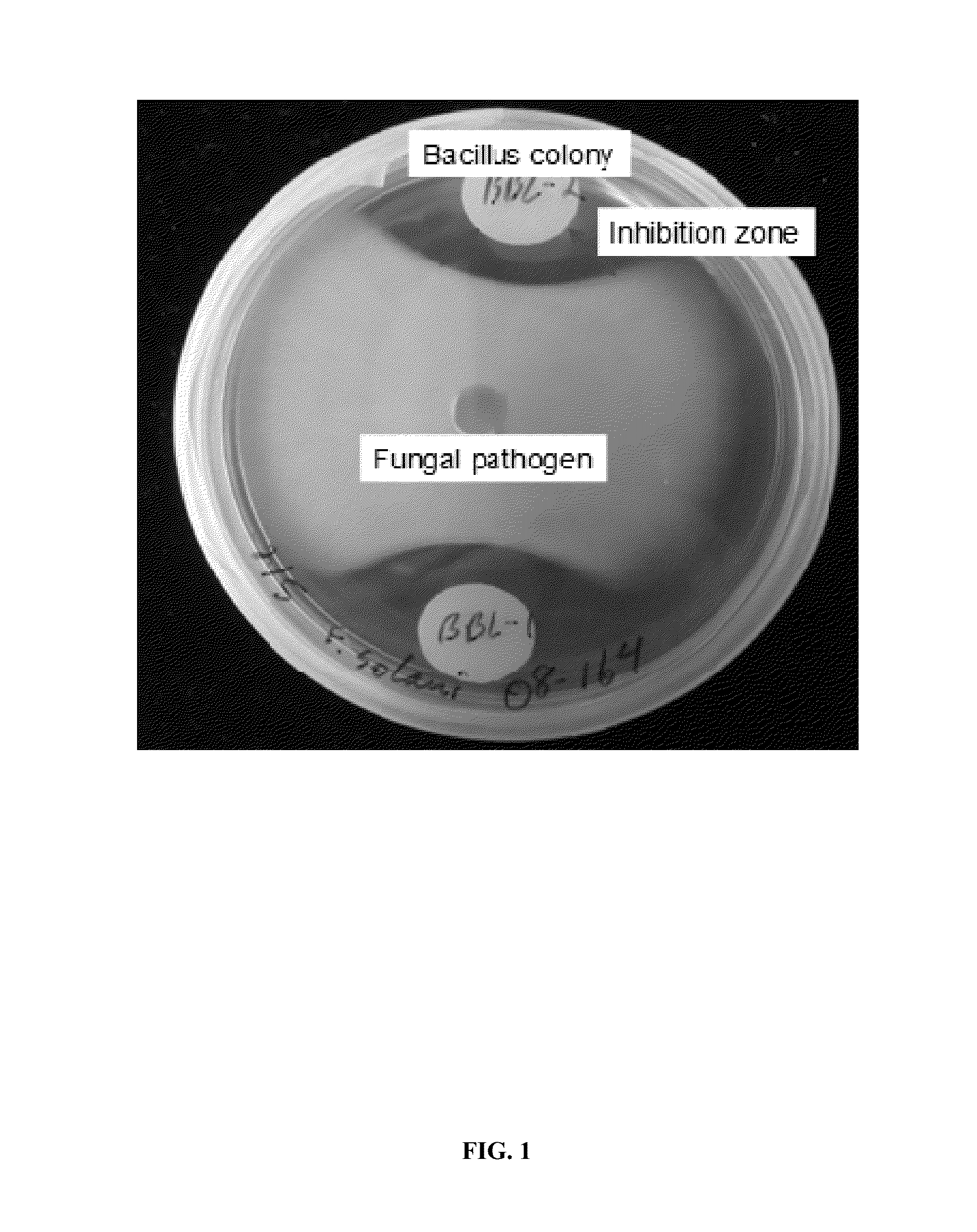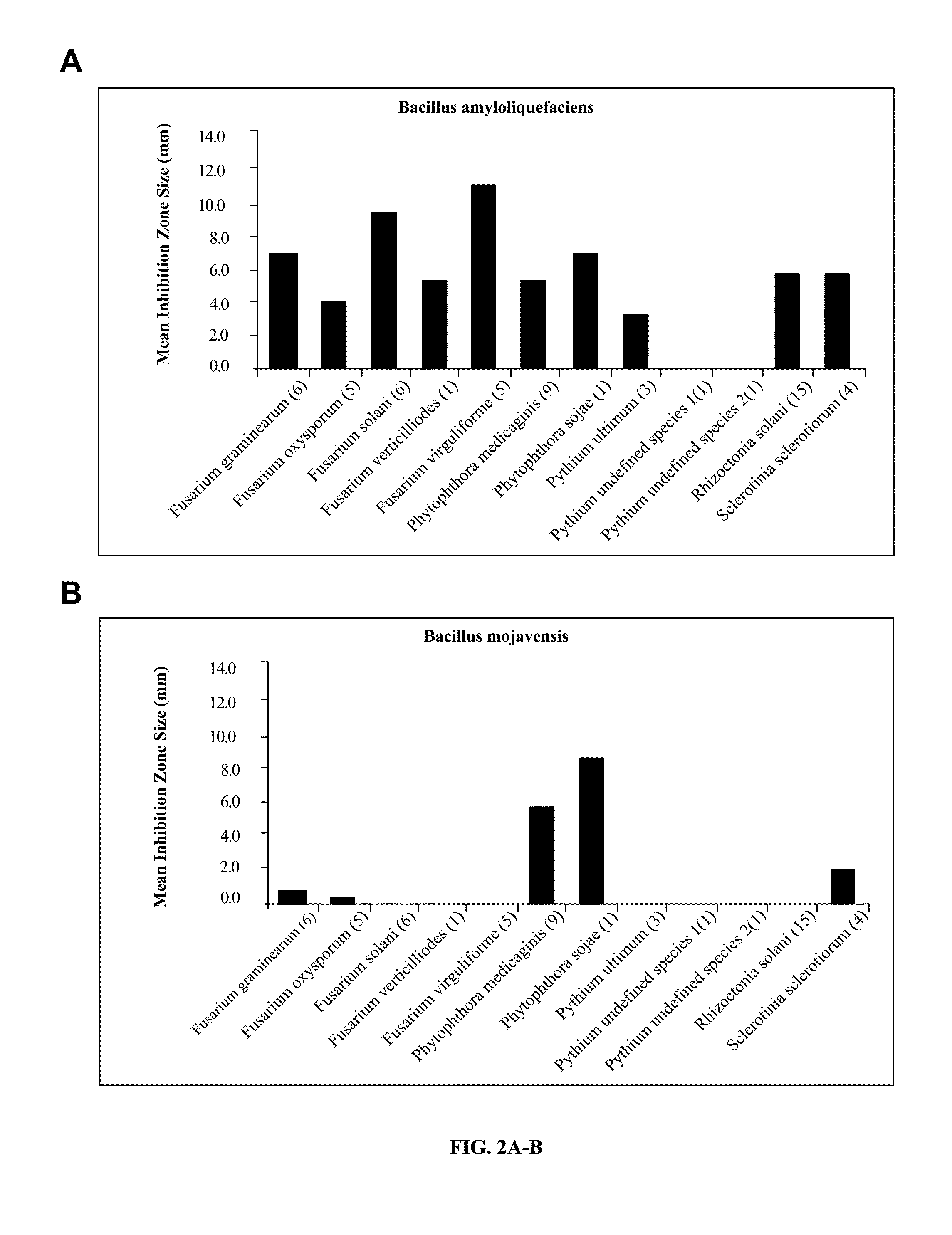Compositions Comprising Bacillus Strains and Methods of Use to Suppress the Activities and Growth of Fungal Plant Pathogens
a technology of bacillus and bacillus, which is applied in the field of compositions comprising bacillus strains and methods of use to suppress the activities and can solve the problems of difficult and expensive to ensure uniform end-products, difficult to obtain the regulatory permits required for sales and marketing of such products, and no benefit to microorganisms. , to achieve the effect of suppressing the activity or growth of fungal plant pathogens and increasing the yield of plants
- Summary
- Abstract
- Description
- Claims
- Application Information
AI Technical Summary
Benefits of technology
Problems solved by technology
Method used
Image
Examples
example 1
Screening for Fungal Inhibition
[0085]A standard agar-plate-based zone-of-inhibition method was used to screen select members of the Bacillus, Brevibacillus, or Paenibacillus genera comprising 9 different species and a total of 11 different strains. The 11 strains of Bacillus, Brevibacillus, or Paenibacillus and their identity are given in Table 2. The 13 species of fungal plant pathogens tested are listed in Table 1.
[0086]The zone-of-inhibition screening methodology is given in FIG. 1. Fungal pathogen species were grown on Potato Dextrose Agar (PDA) except for Phytophthora which was grown on V8 Agar. All fungi were stored at 4° C. until used. Bacillus strains were subcultured in LB broth overnight at 37° C. with shaking at 200 rpm. The subculture (0.5 ml) was used to inoculate 50 ml LB broth and grown overnight at 37° C. with shaking at 200 rpm. An 8 mm plug from the center of an agar plate (TSA, 6.5 pH) was removed. An 8 mm plug of pathogen was placed in the empty hole. 10 μl of th...
example 2
Compatibility of Bacillus Concentrates with Bradyrhizobium and Trichoderma
[0096]Selected Bacillus concentrates and individual Bacillus cultures were tested for inhibition of two beneficial soil microbes Bradyrhizobium, a naturally occurring bacteria of critical importance in legume symbiotic nitrogen fixation, and Trichoderma, a naturally occurring beneficial soil fungus. Commercially available soil inoculant products were used as sources for the two microbes.
[0097]For Bradyrhizobium a cross streak assay was used in which a center streak of Bradyrhizobium was made and then cross streaks of the Bacillus cultures to be tested were streaked perpendicular to and just touching the center Bradyrhizobium streak. Bacillus cross streaks were done at 0, 2, 4 and 6 days after the initial Bradyrhizobium streak and the plates were incubated until good growth was obtained for both Bradyrhizobium and Bacillus.
[0098]From FIG. 5 it is clear that there is no inhibition of growth of Bradyrhizobium b...
example 3
Field Study
[0101]In vitro results may be further confirmed by in vivo greenhouse and / or field trials. During the greenhouse trials each set of 6 plants will be infected with a representative Fusarium, Phytophthora, Pythium, Rhizoctonia, or Sclerotinia in the presence and absence Bacillus strain concentrate. Total plant growth, root mass, and fungal population will be assessed for all sets of plants.
PUM
 Login to View More
Login to View More Abstract
Description
Claims
Application Information
 Login to View More
Login to View More - R&D
- Intellectual Property
- Life Sciences
- Materials
- Tech Scout
- Unparalleled Data Quality
- Higher Quality Content
- 60% Fewer Hallucinations
Browse by: Latest US Patents, China's latest patents, Technical Efficacy Thesaurus, Application Domain, Technology Topic, Popular Technical Reports.
© 2025 PatSnap. All rights reserved.Legal|Privacy policy|Modern Slavery Act Transparency Statement|Sitemap|About US| Contact US: help@patsnap.com



